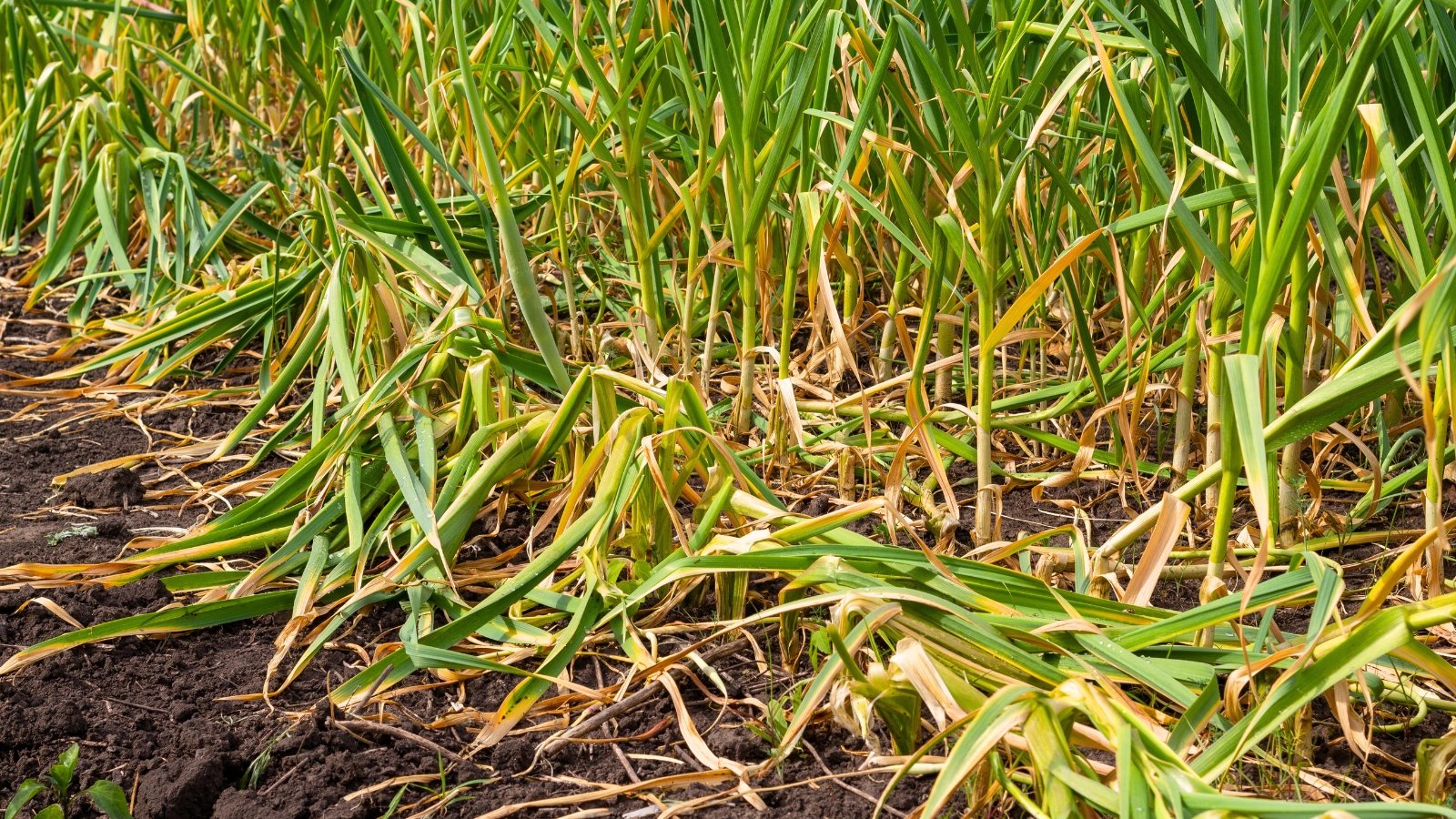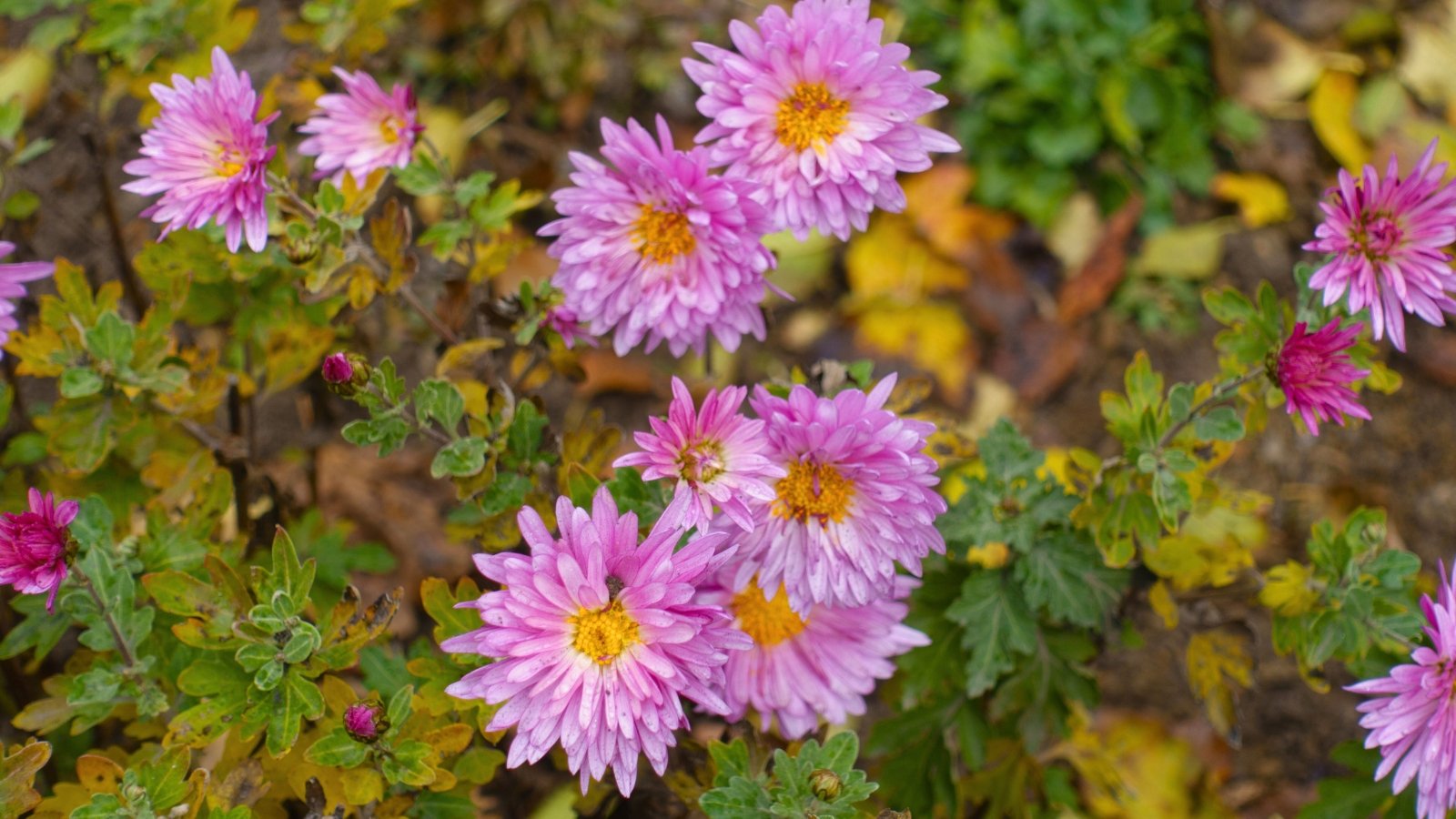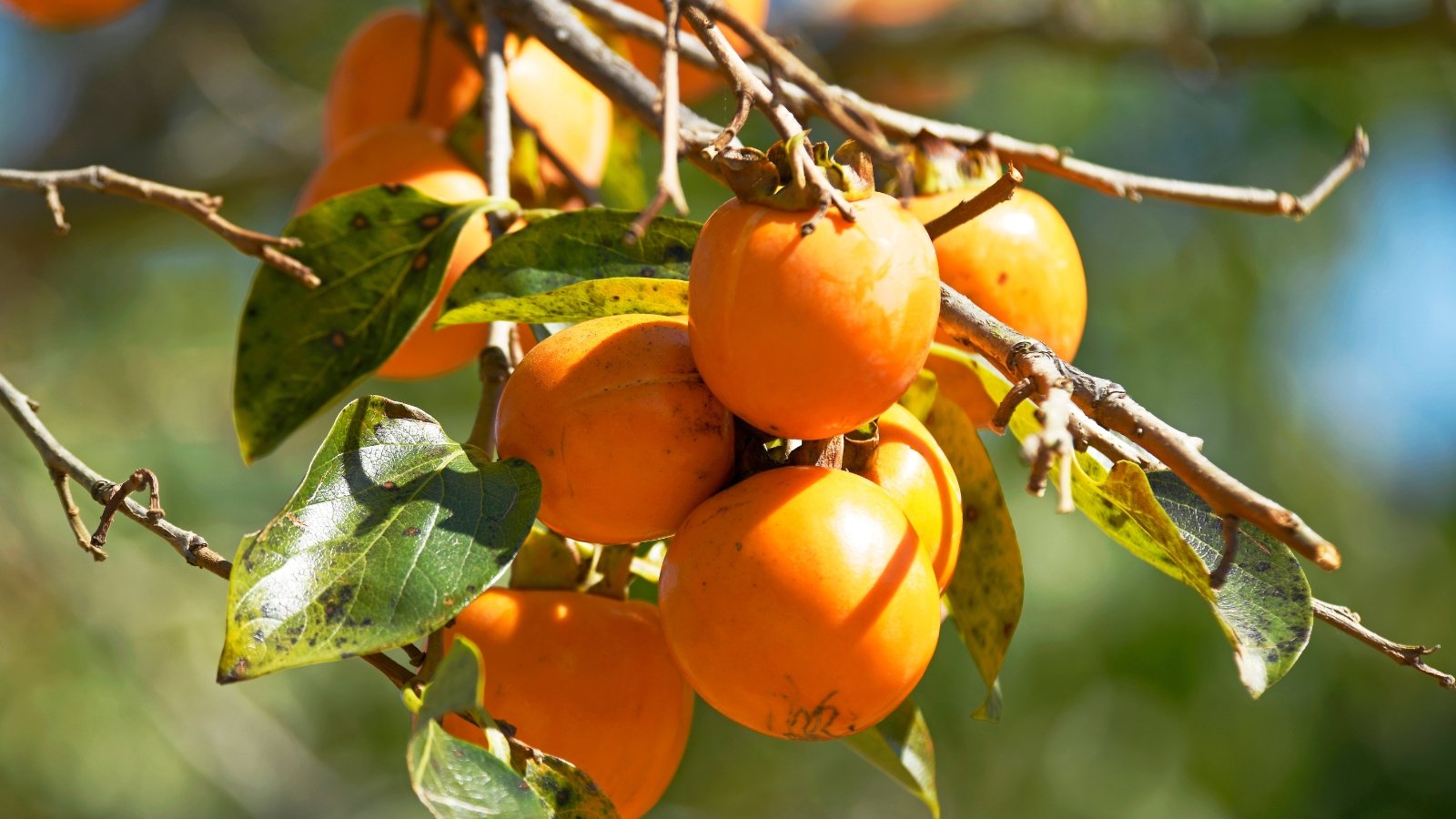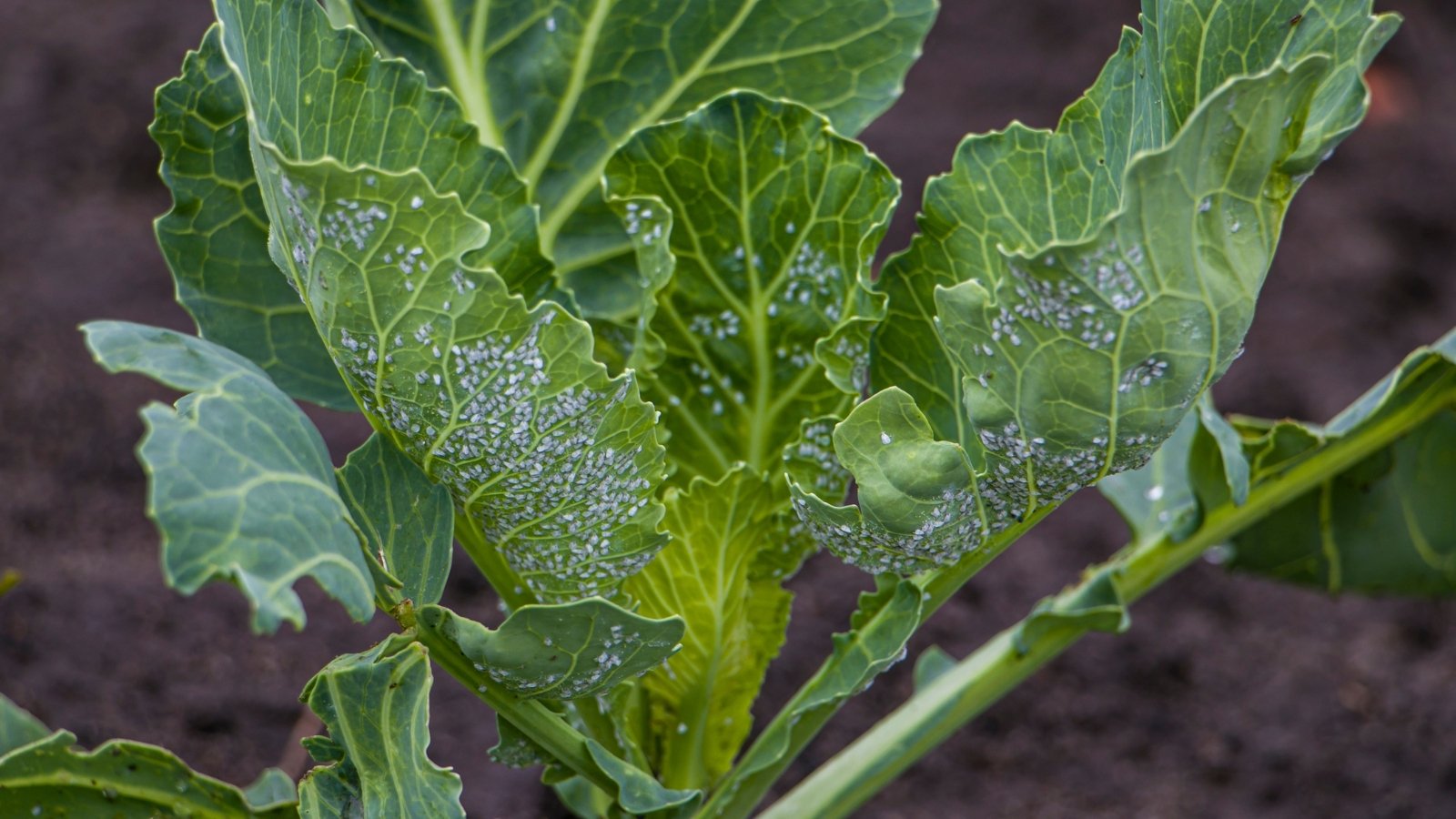
What’s Consuming My Cabbage? 15 Widespread Cabbage Pests
[ad_1]
You’re most probably rising cabbage because you have the benefit of consuming it. And for individuals who’ve ever tried rising this crop sooner than, you probably discover that quite a few yard pests moreover have the benefit of consuming cabbage. This textual content explores potential culprits and strategies to eliminate them.
Cabbage is a member of the mustard family, typically referred to as the Brassica family, or crucifers. Totally different acquainted brassicas embrace broccoli, cauliflower, Brussels sprouts, kale, collards, turnips, mustards, and horseradish. These are primarily cool-weather yard greens that love full photo voltaic and moist, rich soil with superb drainage.
This brassica is usually a spring or fall crop the place it enjoys cool days and cooler nights. It even tolerates gentle frosts. No matter its chilly hardiness, this tasty leafy inexperienced vegetable is susceptible to varied insect pests which will shortly decimate a cabbage crop.
Merely as there are a whole lot of sorts of cabbage, there are moreover quite a few utterly completely different species of caterpillars and caterpillar-like pests that love munching on the leaves. Moreover, you’ll uncover aphids, flies, and beetles. It’s essential to appropriately decide the pests in your crops so chances are you’ll take relevant movement to cope with them.
Seize a magnifying glass and a bit little bit of endurance as we have a look at 15 frequent, and often very small, critters that wish to eat these heading brassicas.
Aphids
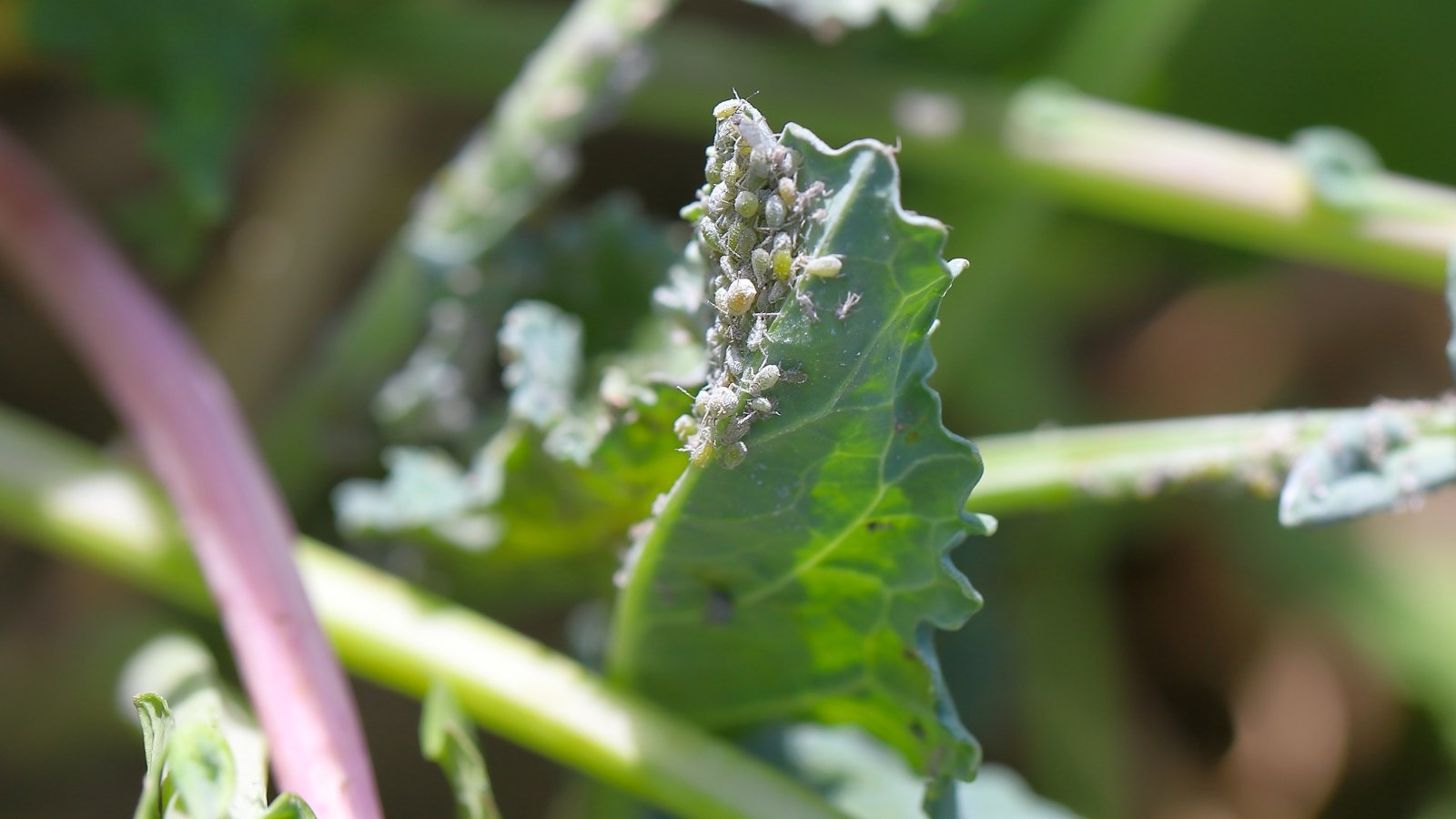

Aphids are ubiquitous yard pests. You’ll see them gathering in huge numbers alongside the leaves and stems of many yard crops. They’re moreover eager on cabbage and congregate alongside the veins of the outer leaves.
These soft-bodied bugs are clearly seen to the naked eye. They could possibly be inexperienced, gray, white, yellow, or pink. Usually, brassica aphids might sound inexperienced nonetheless with a white waxy or powdery-looking masking. Aphids suck plant juices and set off the leaves to alter into withered, curled, and weak, in the end turning yellow and brown, and ultimately dying.
Use a sturdy jet of water out of your hose to dislodge aphids. A every day blast of water is usually ample to discourage aphids from coming once more. You possibly can even use insecticidal cleansing cleaning soap to efficiently kill aphids, spraying it instantly on groups of these pesky little bugs.
Cabbage Looper
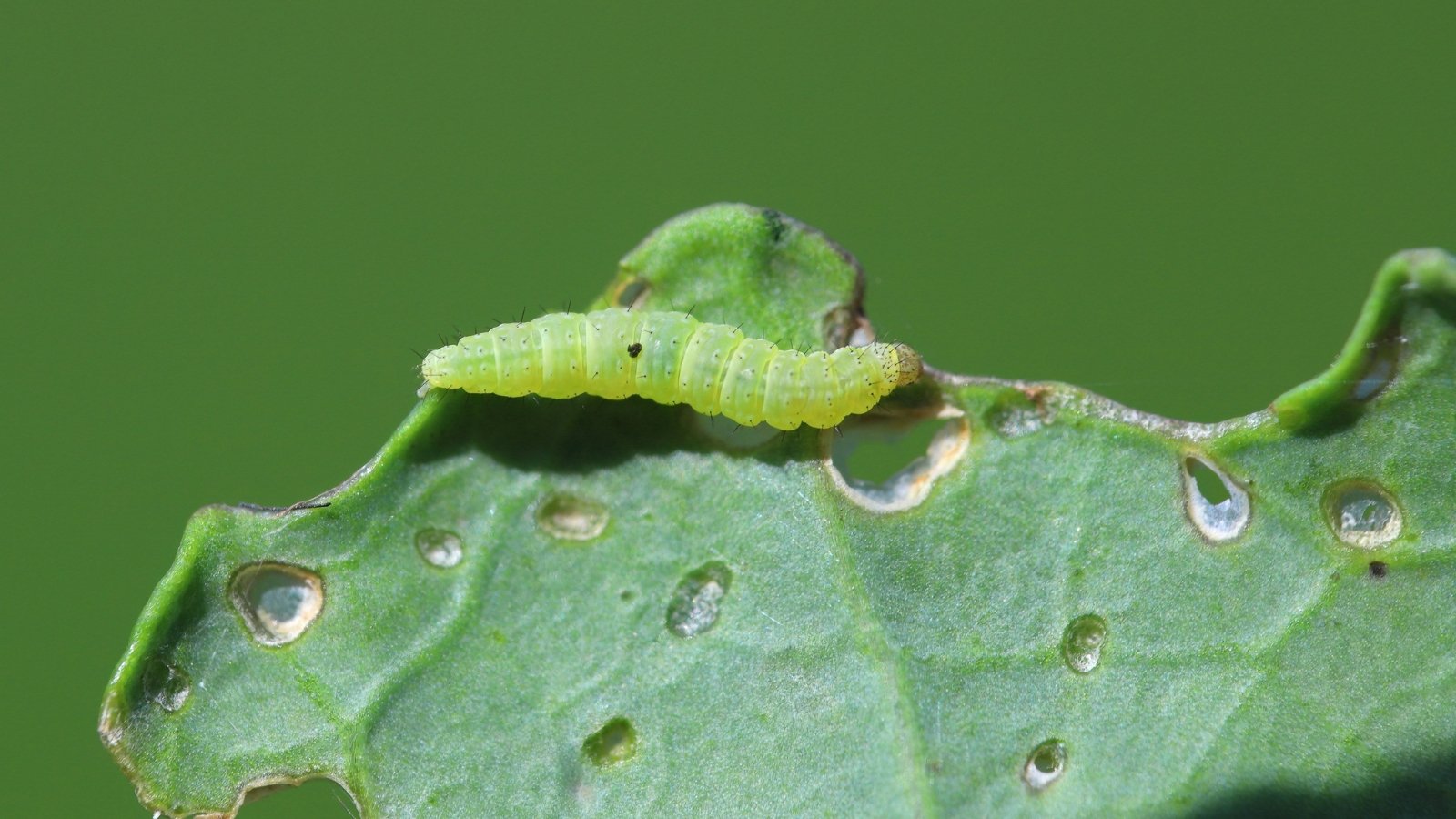

Cabbage loopers are vivid inexperienced inchworms which is likely to be a major pest of this crop’s leaves. They switch by inching alongside because of they’ve no legs throughout the heart part of their physique. These are the larvae of an unassuming mottled brown-gray moth often known as the cabbage looper moth. The grownup moth lays its eggs on a brassica plant, and a few days later, the eggs hatch into voracious little caterpillars.
These hungry little caterpillars chew holes throughout the leaves and develop shortly from only some millimeters prolonged to about 1.5 inches prolonged. They munch gaping holes throughout the leaves anyplace they’re going to attain. A badly infested plant might have leaves riddled with many huge, jagged holes.
Cabbage loopers are fairly frequent pests and the larger they develop, the additional hurt they set off. They will hold in your crops and eat for 3 or 4 weeks, until they’re in a position to pupate into their grownup moth sort.
Management your crops. In the event you occur to see telltale holes and vivid inexperienced inchworm-like caterpillars, you may need cabbage loopers. Cease them by defending your crops with floating row covers; the grownup moths obtained’t be succesful to put eggs on coated crops.
Eradicating caterpillars by hand, BT sprays, and pure predators are environment friendly pure pest administration methods. Pure pesticides can be utilized.
Cabbage Root Maggots
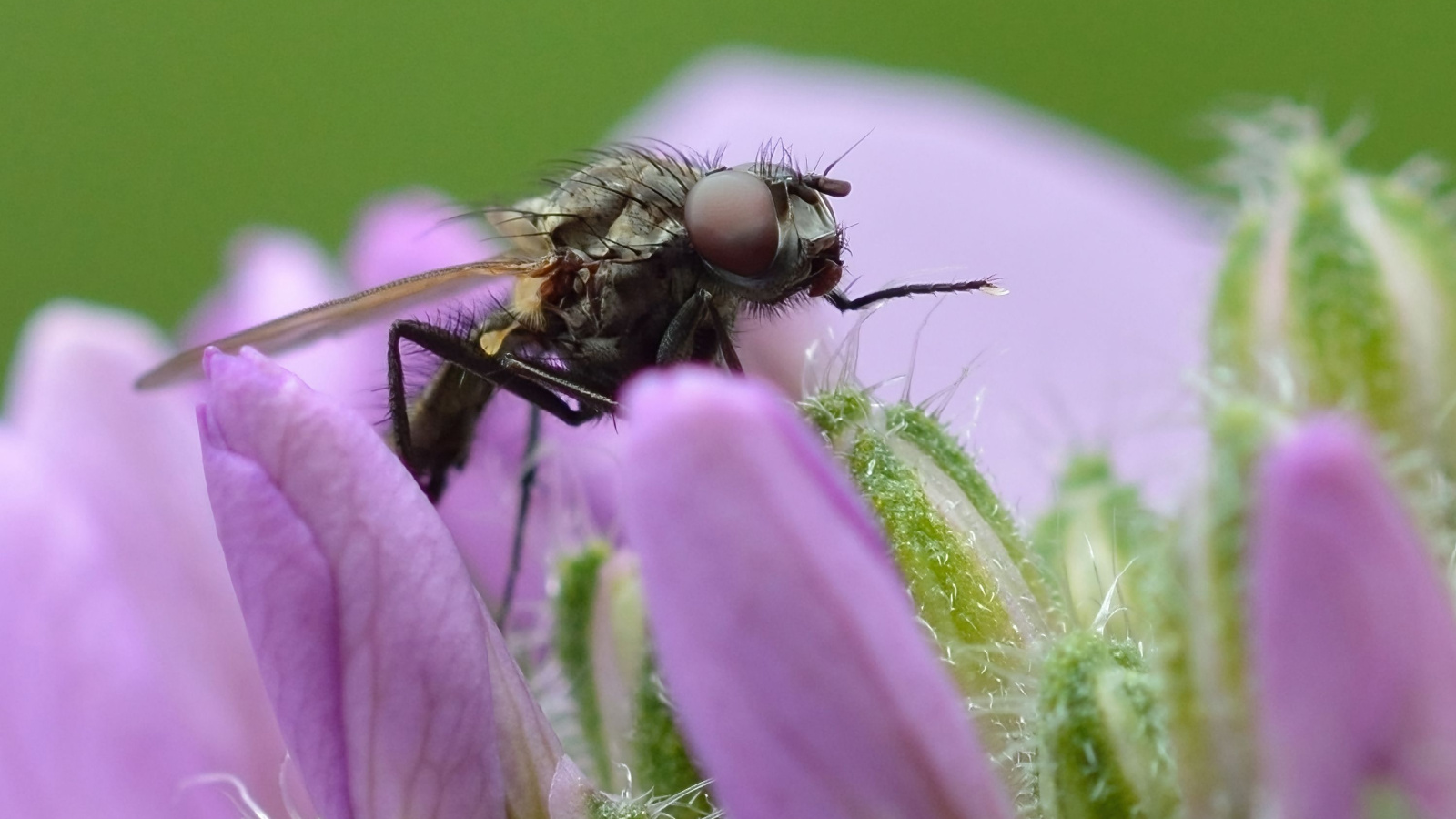

Cabbage root maggots are the larvae of the cabbage root maggot fly, a brownish-gray fly measuring between 5 and seven millimeters prolonged. The grownup fly lays its eggs throughout the soil on the bottom of a bunch plant. The eggs hatch and the larvae burrow into the stem and feed on the plant’s roots.
As the muse maggots destroy the stems and roots, your crops begin wilting and the leaves will flip yellow. Shortly thereafter, as a result of the larvae proceed feasting on the muse system, the crops will wilt severely, collapse, and die.
Floating row covers will forestall adults from laying eggs on the stems and tilling the soil after your crops are harvested will help forestall overwintering pupae from maturing. Crop rotation with non-brassica crops will even help forestall a buildup of these pests.
In the event you occur to can delay spring plantings until the soil has warmed considerably, it’ll help kill any eggs that could possibly be present and thus forestall an an infection, although your brassicas may endure from the heat.
Cutworms
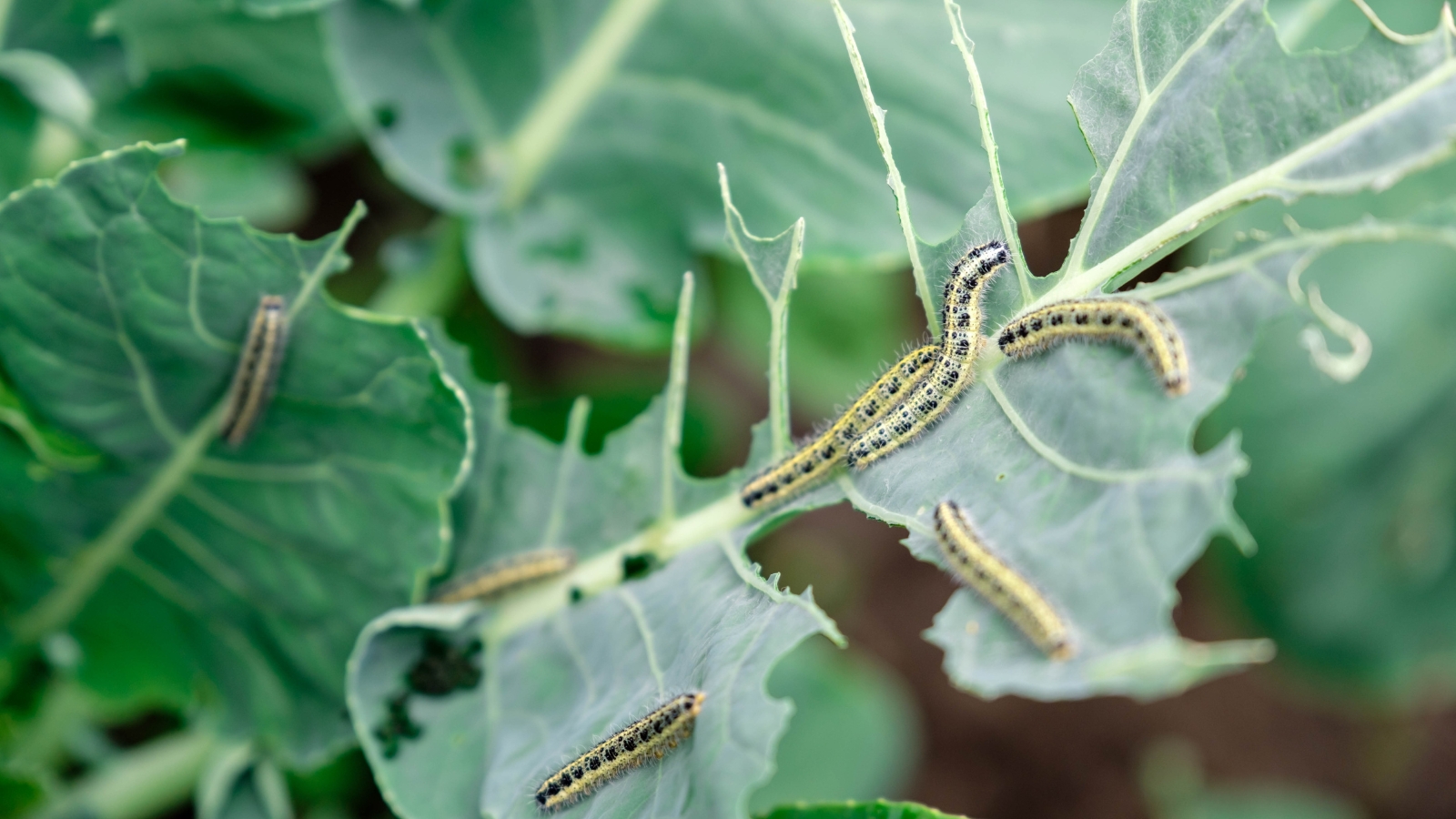

Cutworms are very dangerous, given their small measurement. These little caterpillars decrease correct by means of youthful plant stems, inflicting them to topple over and die. There are numerous species of cutworms nonetheless all of them have the similar strategy of destruction, so it obtained’t matter quite a bit that you just decide the species as long as you acknowledge your crops have succumbed to a cutworm assault.
Cutworms that assault brassicas may vary in coloration, nonetheless all of them appear to have {{smooth}} pores and pores and skin and so they’re successfully camouflaged with the soil, sometimes with brown or gray coloration.
These are the larvae of a brown or gray moth. An grownup moth can lay tons of of eggs, each singly or in small clusters, on the bottom of their respective host crops.
When the eggs hatch, the hungry larvae set to work chewing on leaves or larger crops or slicing smaller crops down solely. Cutworm larvae feed primarily at evening time and conceal throughout the soil all through the day, so it is attainable you may under no circumstances see them, nonetheless you’ll see proof of their chewing the following morning.
Predatory beetles and parasitic wasps prey on cutworms nonetheless this may not be ample to curb cutworm hurt. Maintain your yard mattress weed-free to eliminate their hiding places. In the event you occur to suspect a cutworm downside, use BT to help administration them.
Diamondback Moth
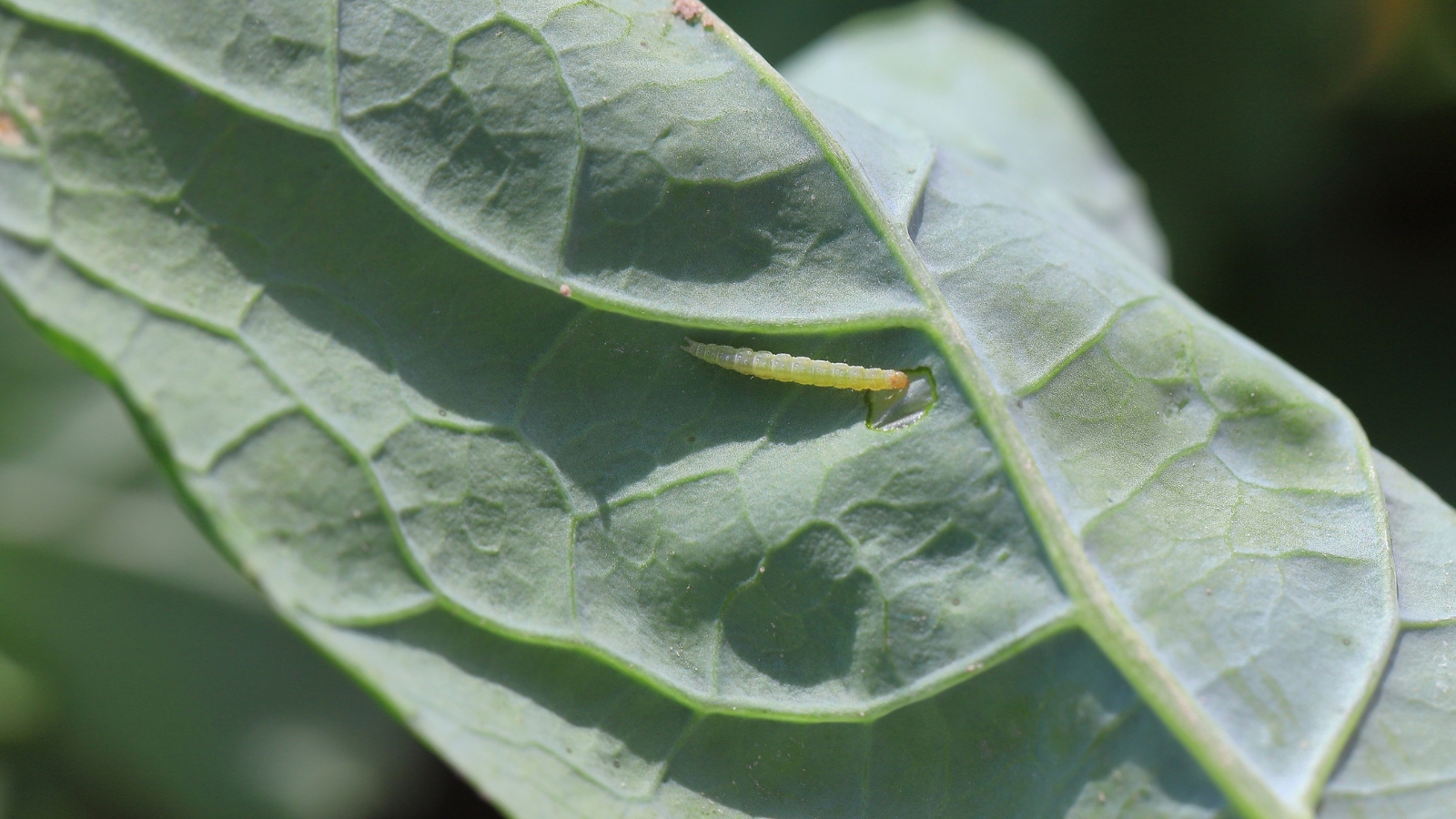

The diamondback moth is found all by way of North America and is a fairly frequent yard pest. The grownup moth is small and slender with patterned brown markings. It lays eggs on all cruciferous greens, along with all types of cabbage, collards, and cauliflower.
Diamondback moth larvae hatch after a few days and immediately start feeding. The small, pale inexperienced caterpillars have tiny black spots on their our our bodies nonetheless no completely different distinctive markings. They not typically attain a number of centimeter prolonged sooner than pupating in a silky cocoon linked to the cabbage leaf.
The larvae are small they often might trigger notable pest hurt, although not as quite a bit as a number of of the completely different frequent cabbage-feeding caterpillars. Diamondback larvae chew by means of layers of leaf tissue with out chewing absolutely by means of the leaves. It’s a distinctive distinction between these and most completely different frequent caterpillar pests.
For pure, chemical-free administration methods, use row covers to cease adults from laying eggs, and hand-pick explicit individual caterpillars. Develop cabbages interplanted with non-cruciferous greens and herbs to discourage pests.
Observe crop rotation and embrace a varied assortment of crops in your panorama to welcome a bunch of useful bugs and insect-eating birds that may assist you administration pesky insect pests.
Cabbage Webworm
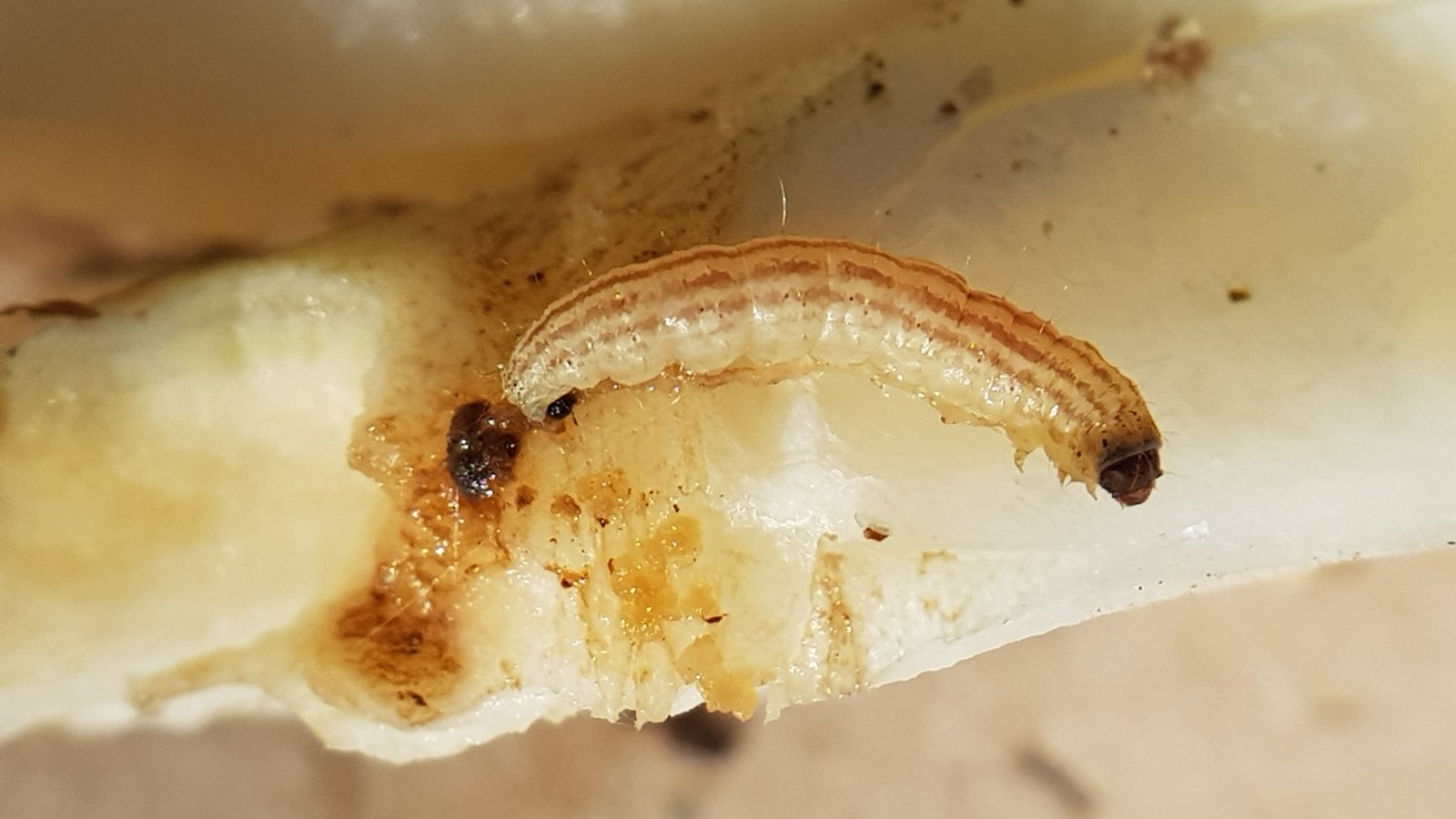

Do you see plump tan to grayish-yellow caterpillars in your crops, turning them proper right into a chewed-up mess? Youthful caterpillars is also a robust tan coloration whereas older caterpillars have distinct brownish strips working laterally alongside their our our bodies.
These are the caterpillars of the cabbage webworm moth, a mottled brown moth measuring about one centimeter broad and fewer than two centimeters prolonged when at rest.
These crucifer-loving caterpillars feed on cabbages, broccoli, bok-choy, collards, and turnips, to name only some of their favorite meals. They often chew up the undersides of leaves with out breaking throughout.
This does ample hurt to set off the crops to wilt and forestall head and flower formation. Contaminated crops will probably be visibly damaged, weak, and brittle as a result of the caterpillars chew into their veins and stems.
These pests are very troublesome to control. Since they conceal out on the undersides of leaves, they’ll be troublesome to remove by hand and bug predators are inefficient at looking them down.
Pesticides that target caterpillars will be utilized to control them, nonetheless do not forget that these pesticides moreover harm useful bugs and pollinators so use them sparingly and completely to give attention to merely the pests you see.
Imported Cabbageworm
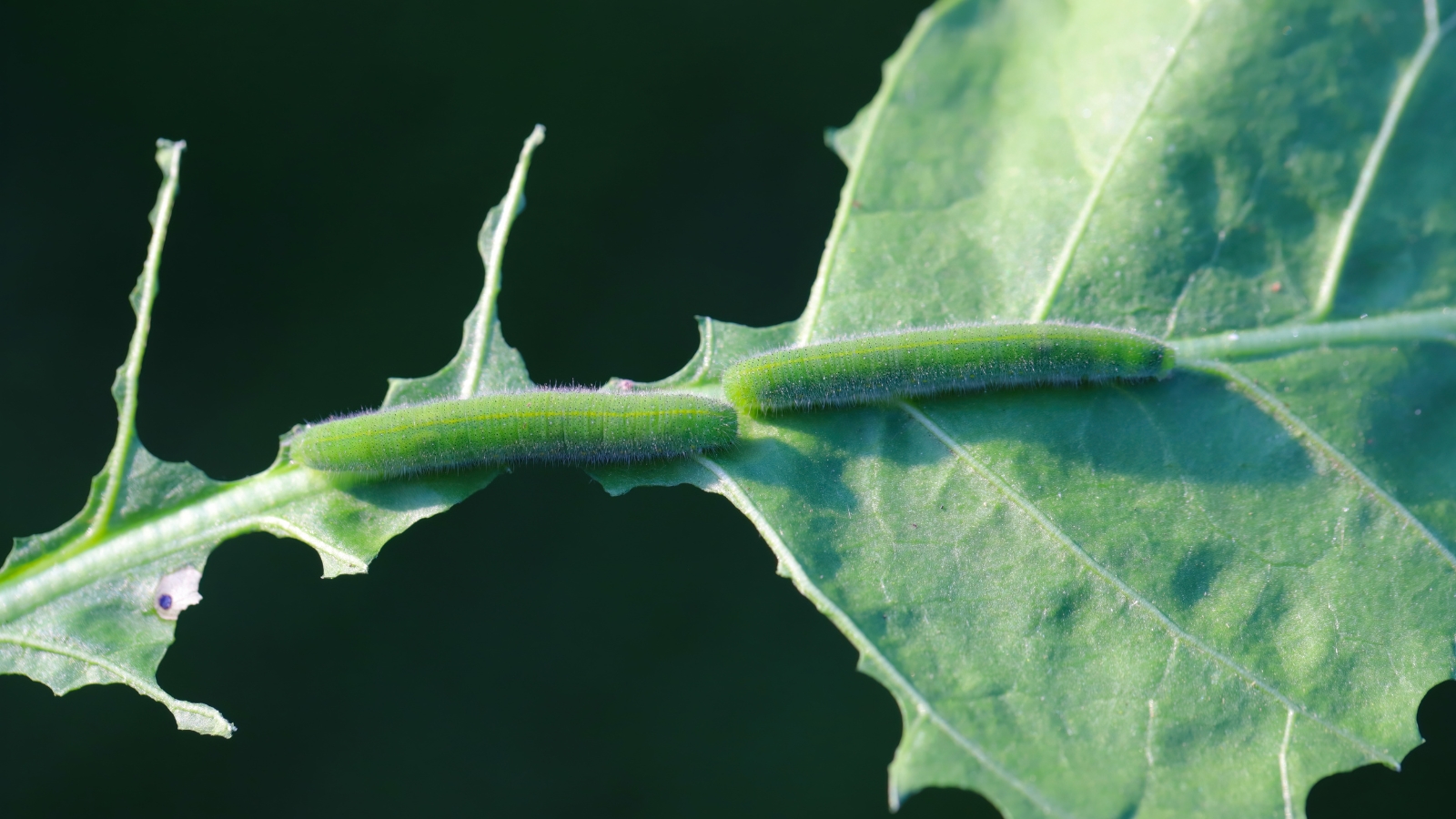

Most caterpillars that feed on cabbage are the larvae of moths. The imported cabbageworm, nonetheless, is the caterpillar of a butterfly known as the cabbage white. These white butterflies are small butterflies with white wings and distinctive black spots on each wing.
It’s a frequent pest that’s associated in look to completely different native species of cabbage white butterflies, although the imported cabbageworm is now the commonest.
These comfy, inexperienced caterpillars measure as a lot as three centimeters prolonged. They’ve a barely ridged, velvety look with pale yellow spots alongside the lower sides of the physique. These caterpillars feast in your crops for about two weeks sooner than pupating each on their host crops or in surrounding leafy particles.
If warmth ample, they emerge as soon as extra as butterflies inside two further weeks, nonetheless later throughout the season, they could overwinter as pupae and emerge as adults the following spring.
The imported cabbageworm caterpillars sometimes feed alongside the larger leaf veins, chewing holes alongside the best way during which. A variety of caterpillars on the similar leaf will shortly reduce the leaf to nothing nonetheless veins. They’re blissful to feed on any cruciferous greens and full of life caterpillars can merely switch from one plant to the next.
Parasitoid wasps, vespid wasps, and assassin bugs are predatory useful bugs that assault these voracious caterpillars. Hand-picking is environment friendly nonetheless tedious because of there’ll sometimes be tons of of these little inexperienced caterpillars in your crops.
Placing in floating row covers on the time of planting could also be very environment friendly at conserving the adults off your crops, because of this reality stopping them from laying their eggs.
Cross-Striped Cabbageworm
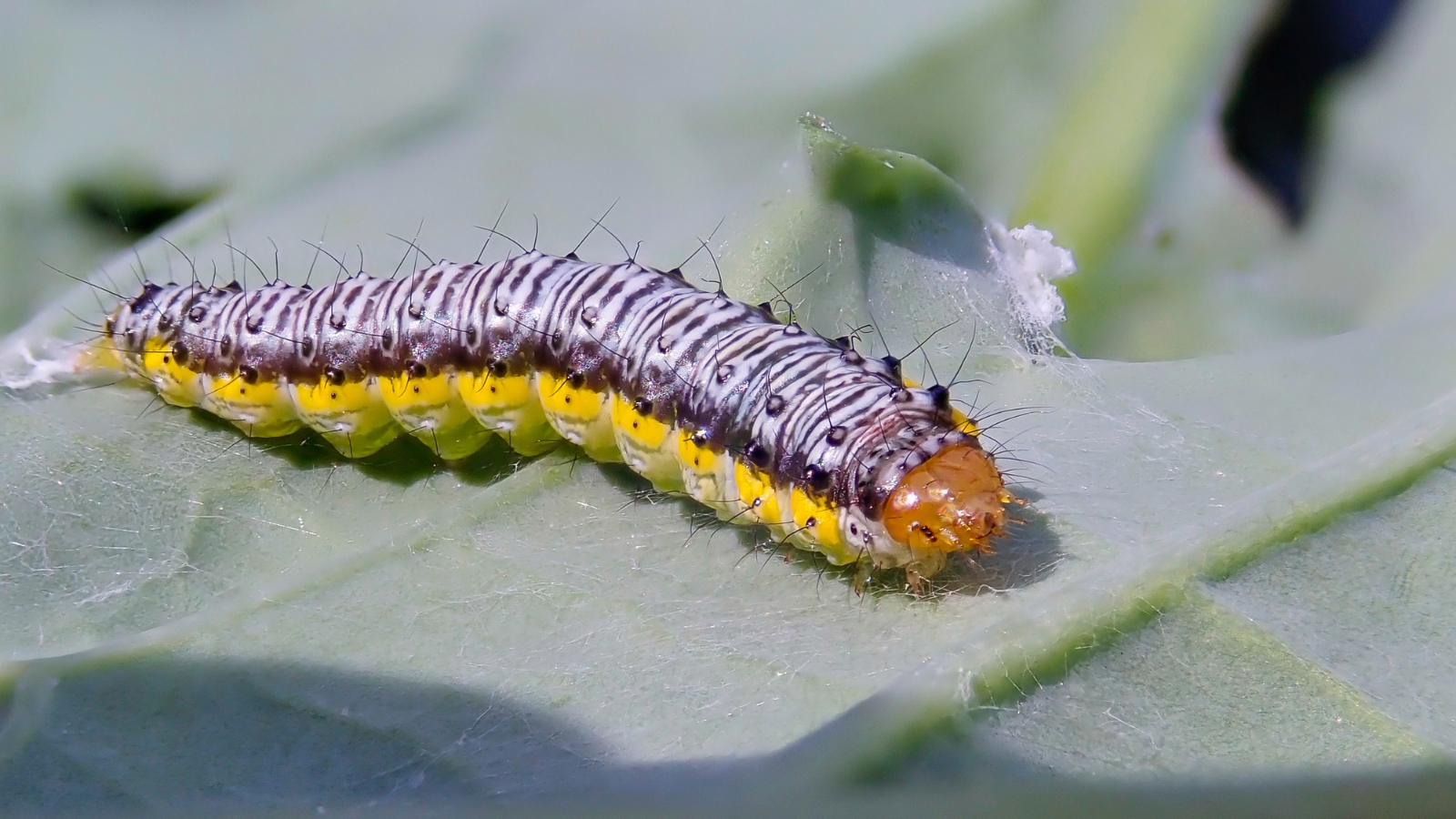

Cross-striped cabbageworms are a the larvae of a moth and are frequent brassica pests throughout the southeastern United States. They feed on cabbage crops, broccoli, cauliflower, and completely different favorite yard brassicas. You’ll uncover their preliminary feeding hurt as holes throughout the leaves, nonetheless as a result of the hurt progresses, the leaves is also solely skeletonized.
You may under no circumstances uncover the non-descript gray-brown grownup moth nonetheless the caterpillars are fairly obvious. They shortly develop from an egg as a lot as about one-inch-long caterpillars. They’ve orange heads, yellowish and gray lateral stripes on their sides, and a white, gray, and yellow speckled pattern on their backs.
These caterpillars are commonest with late-season crops. Cease the grownup moths from laying eggs in your crops by masking them with floating row covers. Invite useful bugs, similar to parasitic wasps, to your yard to help administration caterpillar pests. Attempt eradicating explicit individual caterpillars by hand in case you have got only a few cabbage crops.
Southern Cabbageworm
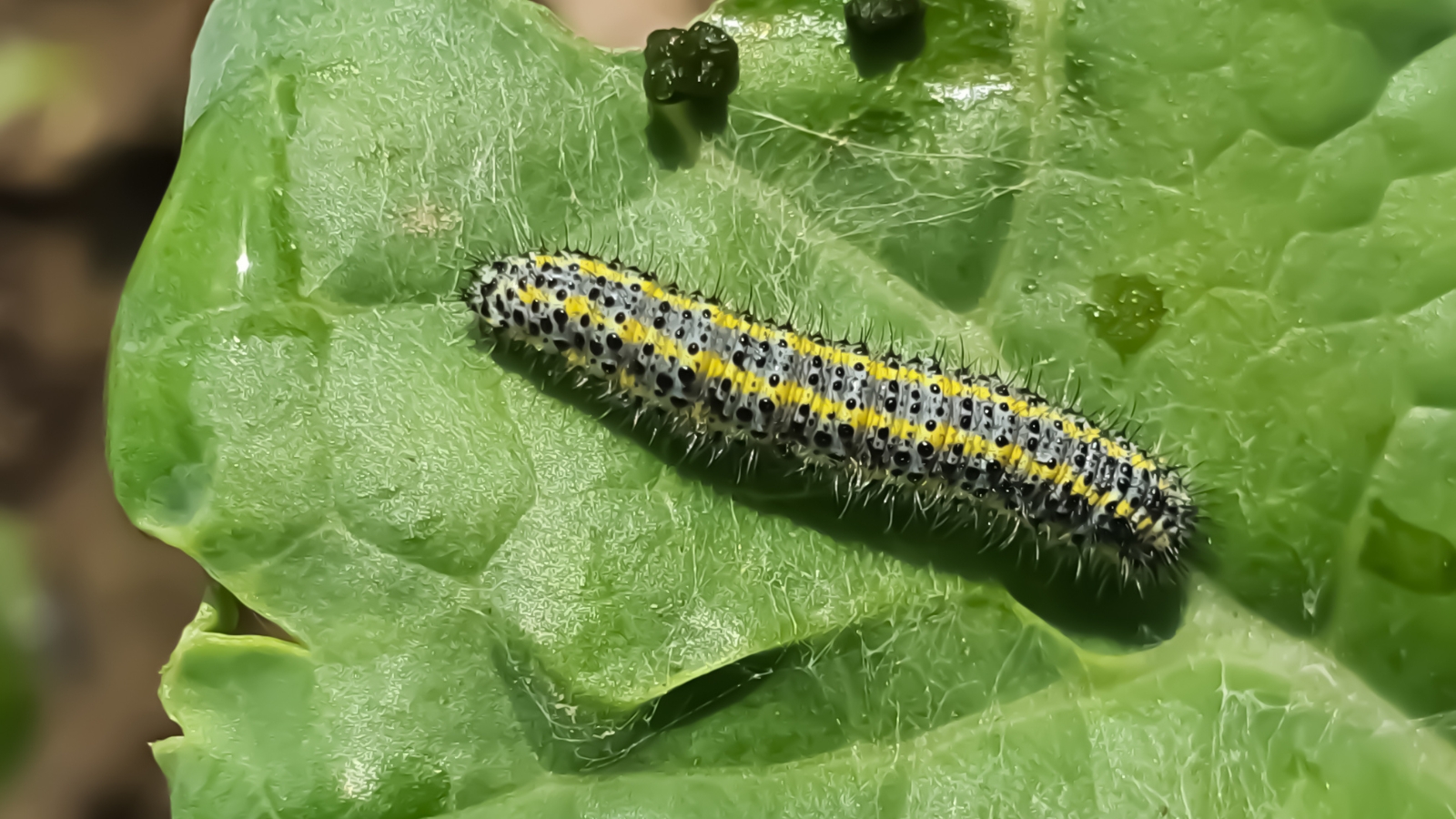

The southern cabbageworm is a typical pest all by way of a whole lot of the southern United States, although it may be found in extra northern states. It is the larvae of the checkered white butterfly which lays its eggs on brassica crops.
The caterpillars then feed on the leaves until they attain maturity and pupate into the next know-how of grownup butterflies.
Southern cabbageworm caterpillars attain merely over one inch in measurement. They’re gray and yellow striped, with tiny, irregular black spots and coarse, temporary hairs. You’ll see the caterpillars on the leaves, and likewise you’ll clearly see the ragged-edged holes they chew as they feed, typically solely throughout the outer layer of leaves.
These caterpillars look like further of a problem for fall crops than spring crops, they often may not be a problem yearly.
Administration these caterpillars as you may completely different caterpillar pests. Use floating row covers to forestall butterflies from laying eggs in your crops. In the event you occur to easily have a few cabbage crops, spend some time in your patch day-to-day and hand-pick explicit individual caterpillars. Entice useful bugs to your yard which will feed upon these and completely different caterpillar pests.
Beet Armyworm
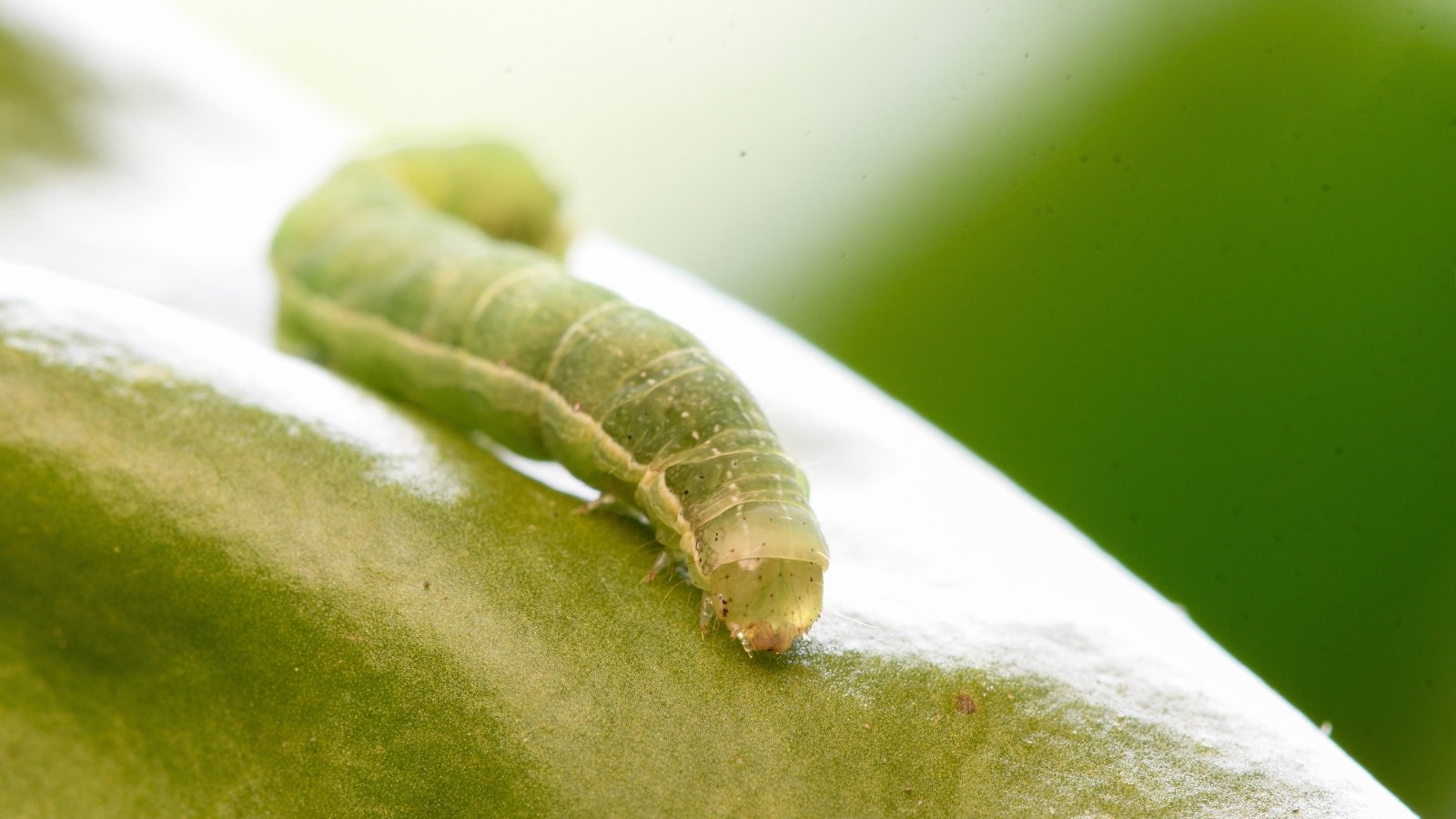

The beet armyworm is a typical pest, considerably throughout the southern United States. That’s the caterpillar of the mottled brown beet armyworm moth. The grownup has a wingspan of about three centimeters and a comfy, fuzzy-looking pale grayish-brown physique.
Adults lay their eggs on all types of yard greens, along with cabbages and completely different brassicas along with many others. In distinction to many butterfly and moth species which have very explicit host crops, the beet armyworm seems to eat completely something.
Each grownup female can lay as a lot as 600 eggs, which signifies that you’re going to attainable have a army of hungry caterpillars feasting in your favorite yard veggies.
The caterpillars are pale inexperienced and plump. Their {{smooth}} our our bodies are each all inexperienced with quite a few inexperienced bands or they’ve a specific reddish-pink line alongside both aspect and a line of darkish spots or powerful ovals above the pink traces. These caterpillars feast their strategy by means of the leaves, making huge irregular holes as they feed.
Prevention is among the easiest methods to control a beet armyworm invasion, using floating row covers on the time of planting to protect your cabbage crop from adults trying to place eggs.
Parasitic wasps and completely different insect predators will happily feed on these plump caterpillars. Pure and natural controls are best for these pests because of they’re largely resistant to pesticides, which ends up in the overuse of ineffective chemical substances and harming useful bugs.
Flea Beetle
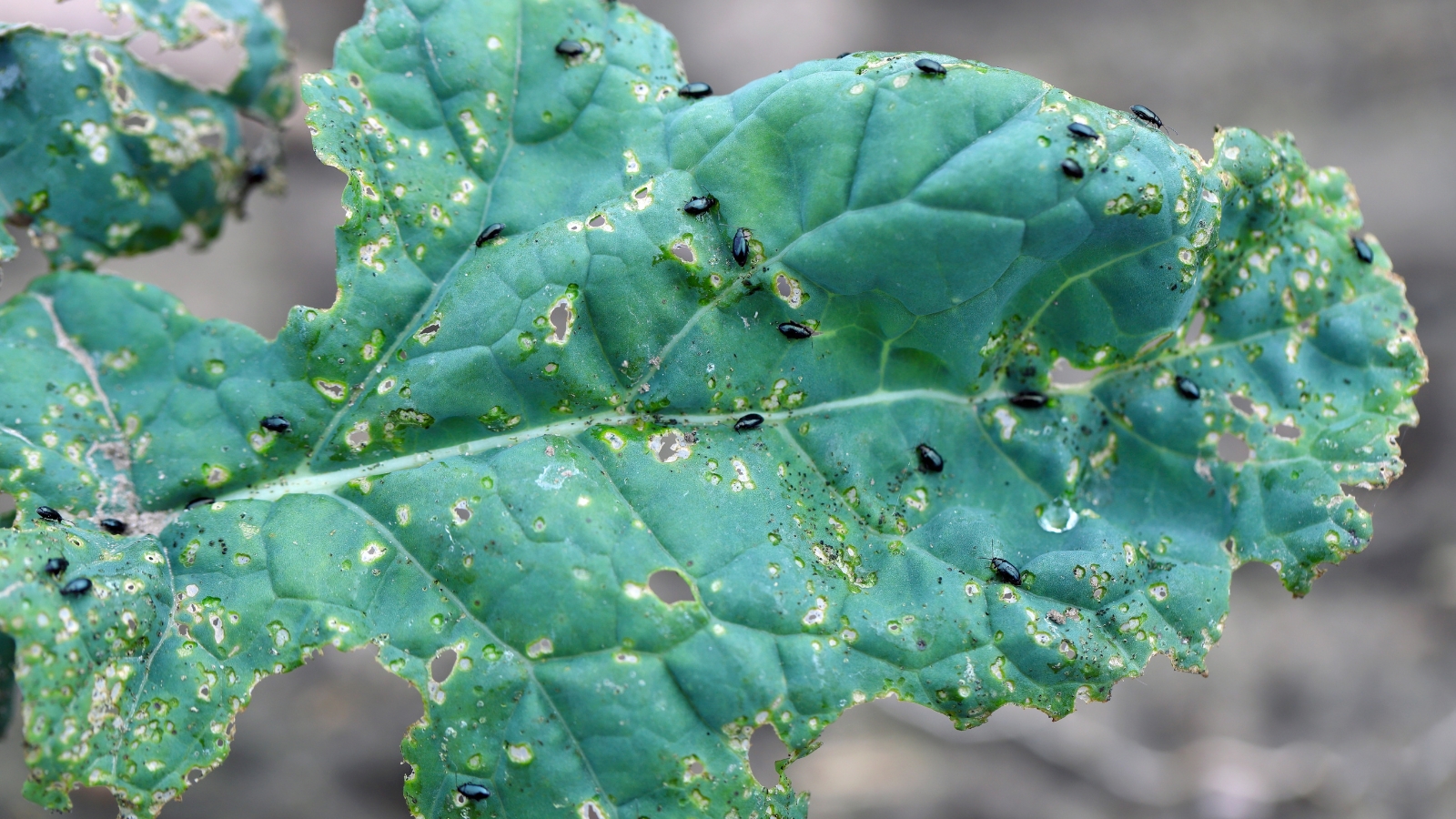

The flea beetle is a small black beetle that feeds on leaves, considerably of youthful crops. They chew many tiny holes throughout the leaves and if quite a few beetles are present, as they typically are, they’re going to merely destroy seedlings sooner than they’ve a possibility to develop. These tiny beetles have the conduct of springing from one place to a distinct, incomes them their determine.
Flea beetles don’t think about cabbages or brassicas, they chew up many alternative yard crops as successfully, along with beans, eggplants, and tomatoes. In case you have got these pests in your yard all through one season, chances are you’ll depend on to see them persist by means of the whole rising season, damaging quite a few crops to the aim of oblivion.
These persistent pests are troublesome to control nonetheless there are some preventative measures you should take for individuals who’ve seen these beetles sooner than. Till your yard throughout the fall to disclose any buried bugs and eggs that could possibly be hiding throughout the soil.
Add useful nematodes to your soil to feed on the soil-dwelling beetle larvae. You possibly can even try companion planting with mint and basil to help repel flea beetles and completely different pests, along with attraction to useful bugs to your yard. Pyrethrin and spinosad are pure pesticides you must use along side cultural and preventative controls.
Harlequin Bug
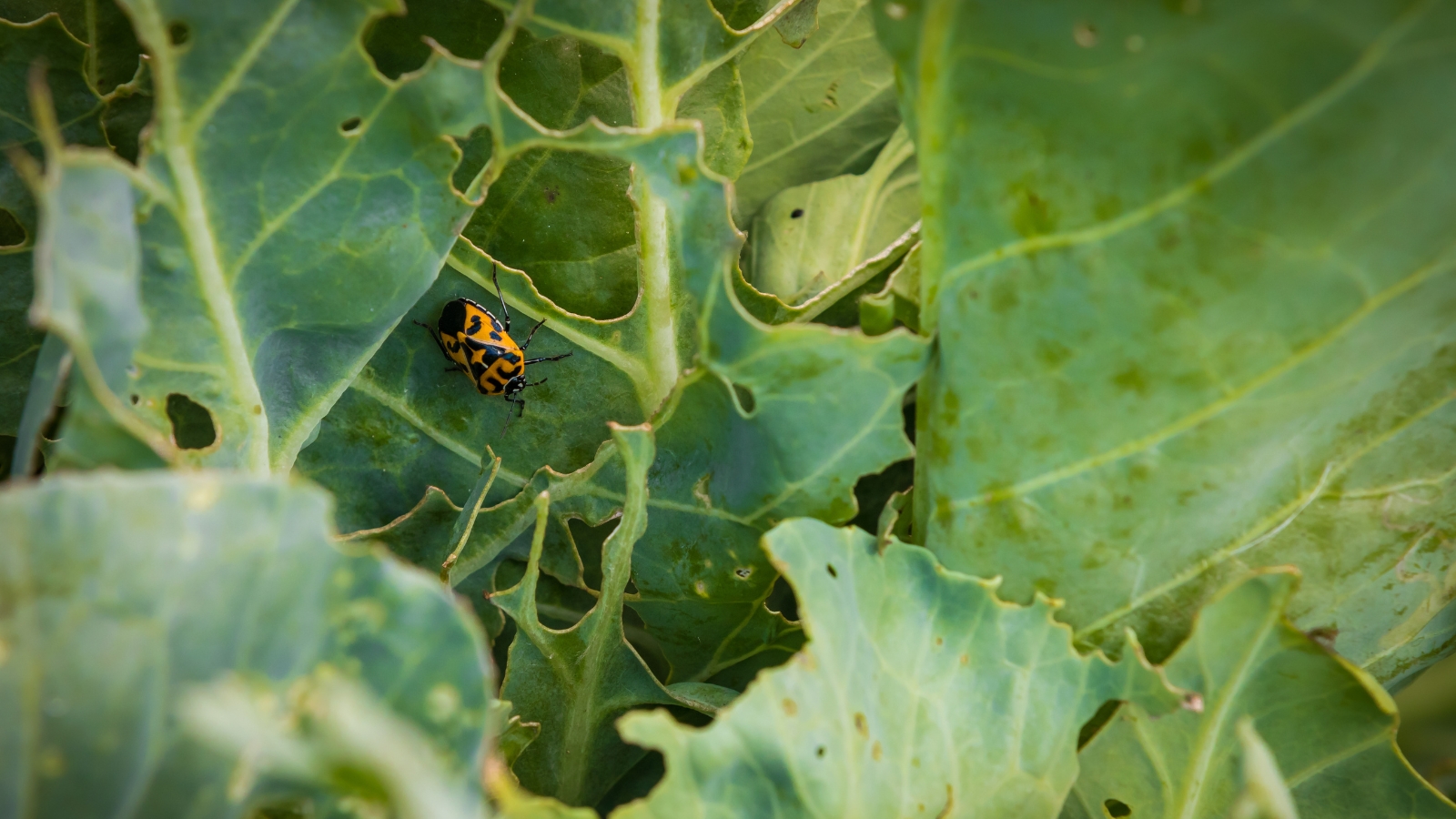

Harlequin bugs are dangerous insect pests that feast completely on cabbages and completely different cruciferous greens. They’re prevalent all by way of the southern half of the US and should set off vital harm if not managed.
The black and white banded eggs are laid on the undersides of the leaves of a acceptable host plant. The eggs hatch into tiny spherical, dome-backed insect nymphs with vivid orange and black markings. At this stage, they could practically be confused with ladybug beetles.
As these bugs develop, develop, and molt, their patterns change, nonetheless all of them have variable patterns of black, white, and orange markings. Grownup harlequin bugs are further merely acknowledged as a species of stink bugs with their angular our our bodies and daring black and purple, orange, or yellow markings.
Harlequin bugs pierce and suck the juices from plant leaves. Affected crops wilt and leaves flip yellow and brown. Plant improvement is stunted and your crops may die if critically contaminated. These insect pests are merely seen and you shouldn’t have any hassle determining them as a result of the culprits.
Administration harlequin bugs by conserving your yard clear and weed-free to reduce habitat for hiding pests. Hand-pick and destroy any eggs, nymphs, or adults that you just see in your crops. If hurt is excessive and you have got a giant infestation, try spraying contaminated crops with an insecticidal cleansing cleaning soap.
Whiteflies
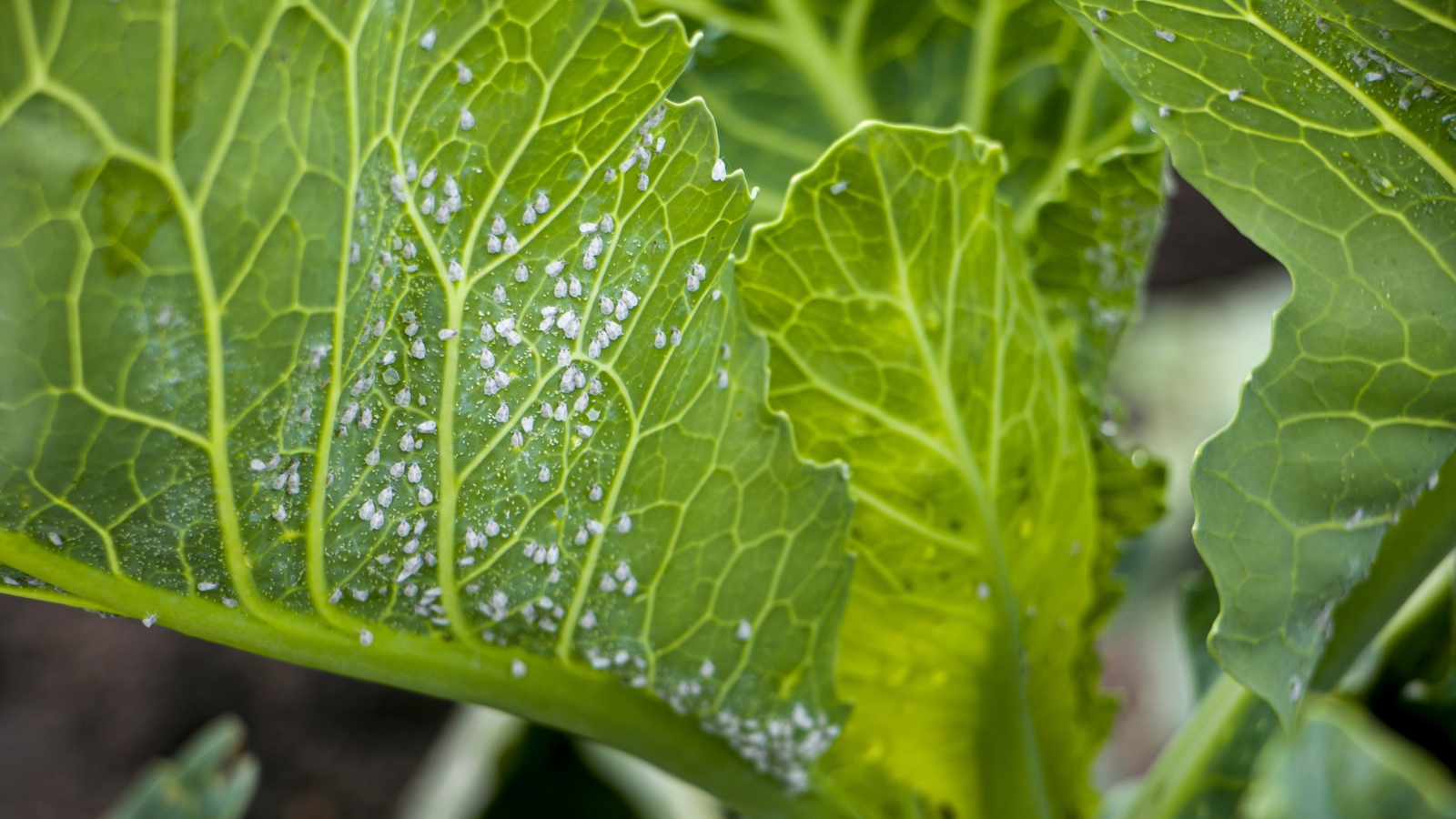

There are numerous utterly completely different species of whiteflies, nonetheless those most continuously found on cabbages and brassicas are the cabbage whiteflies. These are tiny flying bugs which is likely to be, as their determine implies, white.
You may or may not see these little pests nonetheless they do their honest proportion of damage to cabbage crops. They’re most prevalent throughout the fall and often restricted to hotter climates the place they’re going to overwinter.
Whiteflies suck plant juices and it is attainable you may assume that since they’re so small, they shouldn’t set off any vital harm, nonetheless they do. Whiteflies reproduce shortly and shortly dwell in your cabbage leaves in massive numbers. As they suck nutritional vitamins out of your plant, they deposit a sticky honeydew that attracts fungal illnesses that set off extra hurt.
As soon as you buy youthful cabbage crops out of your native yard coronary heart, confirm them rigorously for any sign of bugs, along with whiteflies, sooner than bringing them home. You don’t want to by probability convey these pests into your yard for individuals who can steer clear of it.
Invite and welcome useful bugs to your yard to permit them to prey on these and completely different insect pests. In the event you occur to need further help than the dragonflies and ladybugs can provide, chances are you’ll spray with insecticidal cleansing cleaning soap, nonetheless use this with warning because it’ll moreover harm good yard bugs.
Slugs and Snails
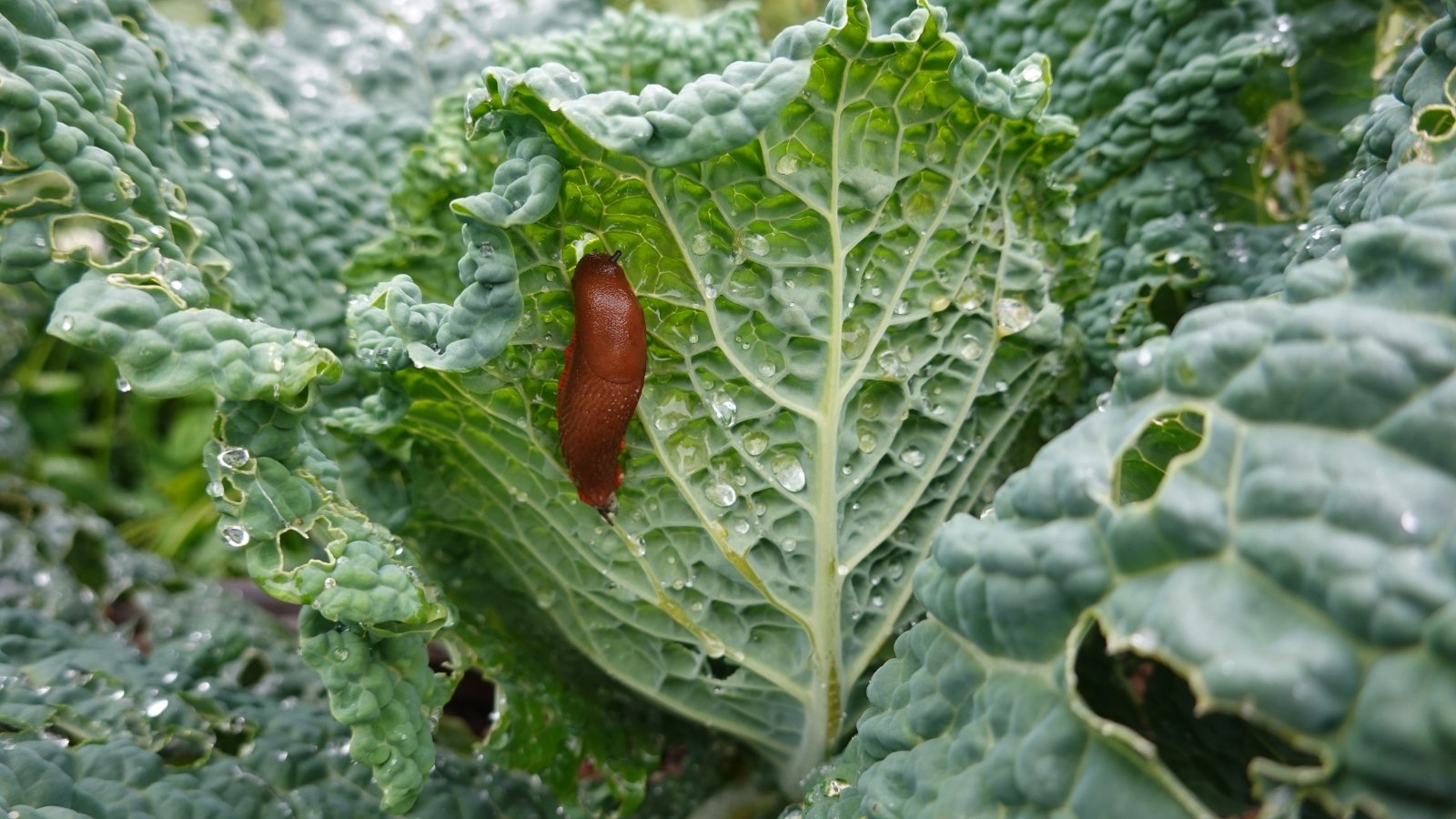

In case you have got any protected, damp hiding places in or spherical your yard, you probably have slugs and snails hiding available on the market. Slugs and snails feed primarily at evening time nonetheless go away telltale slime trails on the leaves and the underside spherical your yard crops. Throughout the morning, you’ll see the hurt they set off inside the kind of smooth-edged holes alongside the perimeters and the services of the leaves.
If given the prospect, these slimy pests feast on cabbages, lettuce, strawberries, hosta leaves, and loads of completely different favorite yard crops.
Slugs and snails lay their eggs throughout the soil, typically under moist leaves, in compost piles, and under wood, stones, and yard planters. Elevate any of these things and likewise you’re extra more likely to see as a minimum a number of snails hiding beneath.
Defend your crops from slugs and snails by eradicating their hiding places. You possibly can even deter them with copper edging and diatomaceous earth, although you’ll should reapply the diatomaceous earth after rainfall. One different trick to try is setting beer traps which magnetize slugs away out of your crops and drown them.
Mammals
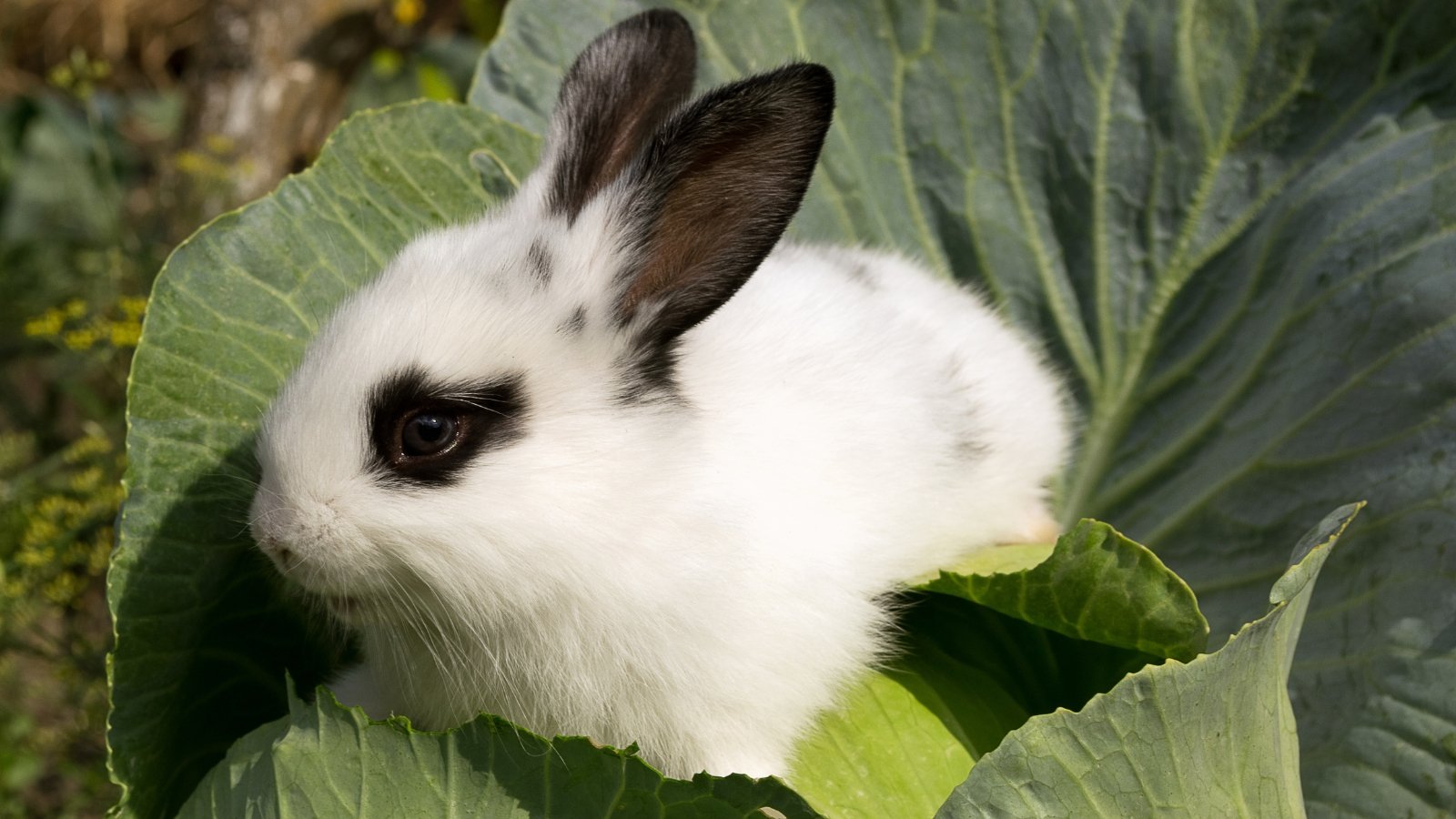

Deer, rabbits, squirrels, mice, and groundhogs eat quite a few yard crops. They might each have their favorite crops to munch and, whereas cabbage may not be on the prime of everyone’s file, trying mammals will most probably as a minimum fashion your cabbages, notably when youthful and tender.
Mammals don’t merely nibble little holes throughout the leaves of your creating cabbage head— they eat the whole issue. In a single chew. Chomp. Gone. It might be irritating, to say the least, to be watching your crops develop, and also you then uncover that the entire sudden they’ve vanished.
In the event you want to protect deer and completely different mammals away out of your cabbages, you’ll should plant your cabbages the place mammals can’t entry them. Plant your yard inside a fenced house.
Use critter cages to protect seeds, seedlings, and youthful crops, and hope that they’ll shortly develop huge ample to be uninteresting to munching mammals by the purpose they’ve outgrown the cage.
Floating row covers moreover work to protect crops from most mammals, as long as larger animals, like deer, don’t merely stroll over them and crush them alongside the best way during which.
Steadily Requested Questions
Pesticides will kill many insect pests. Sadly, they’re moreover toxic to bees, butterflies, pollinators, predatory bugs, and completely different useful bugs. They harm birds that feed on these bugs and organisms that dwell throughout the soil and help protect your soil healthful.
Attempt completely different methods to control insect pests sooner than resorting to pesticides. And for individuals who do decide that pesticides are the reply, keep in mind to be taught and adjust to the instructions rigorously and take precautions in the direction of respiration and touching them, as many are toxic to people and pets along with bugs and wildlife.
Certainly not! Many yard bugs are good in your yard. Pollinators are essential for lots of economically priceless crops to supply fruits. Useful bugs shouldn’t solely pollinators however as well as predatory bugs. Predatory bugs, like ladybugs and dragonflies, eat massive numbers of insect pests and help protect these pest populations low.
You’ll attraction to useful bugs to your yard by planting numerous crops and flowers that bloom at utterly completely different cases of the 12 months. Choose crops which is likely to be acknowledged to be notably participating to useful bugs. Avoid using pesticides in your yard because of they kill all bugs, useful and unhealthy.
Positive. Develop your cabbages and completely different yard crops in probably the greatest conditions chances are you’ll provide. Give them a great deal of daylight, a great deal of water, and a great deal of high-quality nutritional vitamins. Healthful crops are resilient crops!
[ad_2]
Provide hyperlink
